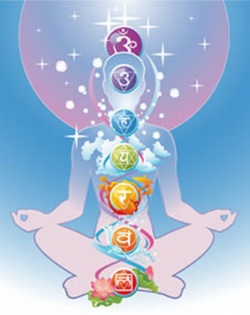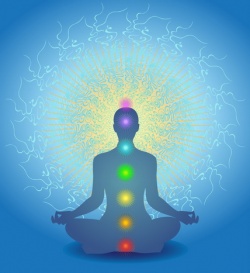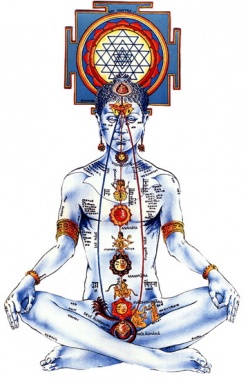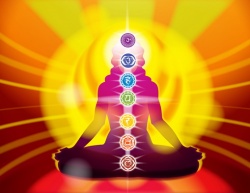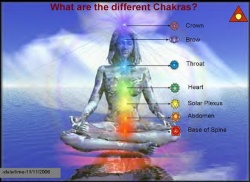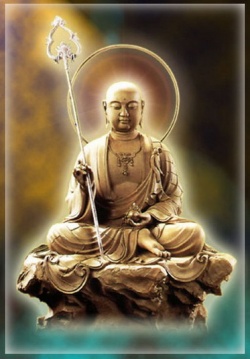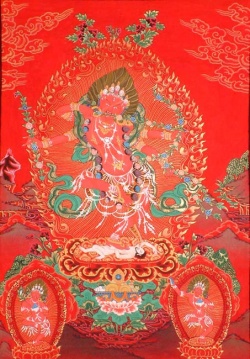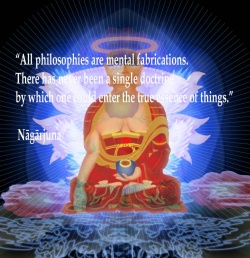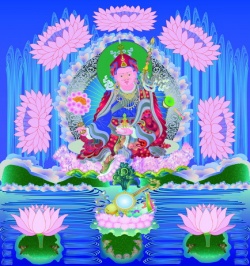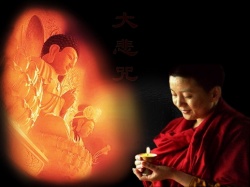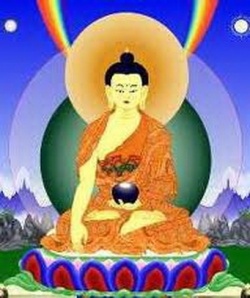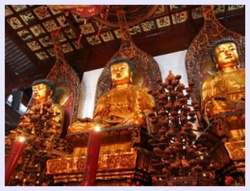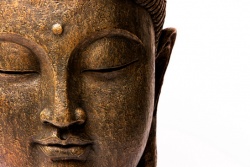Nadis
omposition and Structure
The word nadi is derived from Sanskrit nad meaning hollow stalk, sound vibration and resonance.
Nadis are tubular organs of the subtle body through which energy flows.
Nadis are ducts, channels which carry air, water, blood, nutrients and other substances throughout the body.
They are our arteries, bronchioles, veins, capillaries and so on. In our so called subtle and spiritual bodies, which cannot be weighed or measured, they channel cosmic, vital, seminal and other energies as well as sensations, consciousness and spiritual aura.
Map of nadis From the Atma dwelling in the heart, and the size of a thumb, radiate 101 nadis.
From each of these 101 nadis emanate 100 subtler nadis, each of which branches off into another 72,000.
They are called different names according to their functions.
Nadikas are small nadis and nadichakras are ganglia or plexuses in all three bodies.
It is said in the Varahopanisad that the nadis penetrate the body from the soles of the feet to the crown of the head. In them is prana, the breath of life, and in that life abides Atma, which is the abode of Shakti, creatrix of the animate and inanimate worlds.
All nadis originate from one of two centres; the Kandasthana - a little below the navel, and the Heart. Though yoga texts agree about their starting points, they vary about where some of them end.
Twelve digits above the anus and the genital organs and just below the navel, there is an egg-shaped bulb called the kanda. From it 72,000 nadis are said to be spread throughout the body, each branching off into another 72,000. They move in every direction and have countless outlets and functions.
The Siva Samhita mentions 350,000 nadis of which 14 are stated to be important. The three most vital are Sushumna, Ida, Pingala.8
Your Subtle Energy System
A slightly different angle:-
Pranic energy flows throughout your pranic sheath via fixed pathways, called nadis (conduit, channel or artery), derived from the Sanskrit root nada or nala (motion.) So nadi is energy in motion.
At various focal points within your pranic body, networks of nadis intersect to form chakras (plexuses of subtle energy centres.
As wireless mediums, the subtle energy tubes (nadis) are not physical nerves or arteries, and the vortexes (chakras) are not physical nerve plexuses.
If you dissected a corpse, you would not locate one nadi or chakra anywhere, because they are composed of non-physical substance.
In fact, even under an electron microscope they are undetectable. Yet these subtle energy tubes and centres give the very breath of life to your body.
Without them, your heart would not beat and lungs would not move.
Because they are not readily discernable for scientific investigation, their existence is rejected by Western medicine. However, the nadi system is the essence of Chinese acupuncture and Ayurvedic medicine.
Why are nadis and chakras discounted as myth? Consider a man who never saw a radio or television. If you told him these instruments could pick up signals originating many miles away, he would laugh at you. No wire transmits the signal, yet invisible electromagnetic waves carry it.
Similarly, your body is akin to a radio that receives pranic energy. A healthy body receives these energy waves as a clear, well-tuned radio. An unhealthy body is an old dilapidated radio that distorts the signal.4
The Five Pranas
Prana, in its capacity of the life force in breath, takes five separate forms. These five vital forces (pancha prana) breathe life into your body:
1. Prana (up-breathing) is inward and downward motion. Seated in the heart (anahata chakra), it governs respiration, swallowing, and movements of the gullet.
Prana resides in the eyes and ears, operates in the heart and lungs, and moves in and out of your nose.
2. Apana (down-breathing) is downward and outward motion.
Seated in the anus (muladhara chakra) it governs excretion and the kidneys, bladder, genitals, colon and rectum.
It is responsible for flatulence, ejaculation, conception, childbirth, defecation and urination.
It regulates the sense of smell, makes the body stable, and its range of influence is from the navel to the rectum.
3. Samana (on-breathing) is horizontal motion.
Seated in the navel (manipura chakra), it maintains digestive fire and regulates stomach, liver, pancreas and intestine. its realm of activity extends from the heart to the navel.
Samana carries the grosser product of food to Apana for excretion, and brings the subtler material to the extremities.
The word samana means "equaliser".
The ancient scripture Yoga Sutras says "By conquering the vital force called Samana, effulgence is acquired."
By developing Samana Vayu (current, impulse, vital air), all parts of your body are properly nourished, and the energy supplied by food is evenly distributed.
By controlling Samana, you gain charisma and a powerful aura. It is said in the scriptures that "seven lights" proceed from Samana.
4. Udana (out-breathing) is upward and outward motion. Seated in the throat above the larynx (vishudda chakra), it regulates falling asleep, controls all automatic functions in the head and maintains body heat.
Udana is responsible for speech, music and humming. At the time of death Udana separates the astral body from the physical body.
By controlling Udana, levitation can occur. Udana is responsible for "kundalini" rising up your spine.
5. Vyana (back-breathing) is circular motion, a combination of Prana and Apana, by which these two are held.
All- pervading and moving through all the nadis, it controls the circulatory, lymphatic and nervous systems, directs voluntary and invountary movements of muscles, joints, tendons and fascia, and keeps the body upright through unconscious reflexes.
Vyana is responsible for blood flow and lymph detoxification, sweating and coordination of all systems.
The word Vyana means "pervading one".4
Some nadis
Alambusa - Connects the mouth and anus.
Chandra - (see Ida)
Chitra - One of the nadis emanating from the heart through which the creative energy (Shakti) of Kundalini passes to reach the Sahasrara (crown).
[Of the 101 nadis, only the Chitra splits into two parts at the root of the Sushumna.
One part of the Chitra moves within it, extending upwards to the aperture of (randhra) of Brahma at the crown of the head above the Sahasrara chakra. this is the gateway to the Supreme Spirit (Parabrahman).
The other part of Chitra moves down to the generative organ for discharge of semen.
It is said that at the time of death, yogis and saints consciously leave through the brahmarandhra. Since the aperture is in the spiritual or causal body (karana sarira) it cannot be seen or measured.
When the prana rises upwards, via the Chitra, through the chakras, it takes with it the radiance (ojas), a creative energy latent in semen. The Chitra is transformed into the Brahma nadi or Para (supreme) nadi.
Gandhari - One of the nadis said to be behind the Ida nadi, terminating near the left eye, regulating the function of sight.
Hastijihva - located in front of the Ida nadi, terminating near the right eye, regulating the function of sight, seeing.
Ida - starting from the left nostril, moving to the crown of the head and descending to the base of the spine. In its course it conveys
lunar energy and is therefore called Chandra nadi. Its function is cooling (tamas), inertia.
Kausiki - One of the nadis terminating at the big toes.
Kuhu - One of the nadis said to be located in front of the Susumna, its function is to evacuate faeces.
Kurma - subsidiary nadi whose function is to stabilise the body and the mind.
[[Payaswini] - One of the nadis terminating at the right big toe, said to be located between the pusa (which is behind the pingala nadi and the Sarasvati (behind Susumna).
Pingala - (= tawny or reddish) starting at the right nostril moving to the crown and down the spine to the base. As the solar energy flows through it, it is also called Surya nadi.
Its function is burning (rajas), action.
Pusa - nadi situated behind Pingala, terminating at the right ear. Function is hearing.
Raka - nadi creates hunger and thirst and collects mucus at the sinuses.
Samkhini - terminates at the genital organs, is situated between Gandhari and Sarasvati. It carries the essence of food.
Sarasvati - nadi which is behind Susumna nadi, terminating at the tongue, controlling speech and keeping the abdominal organs free from disease.
Soma - see Ida.
Subha -
Sura - nadi which is between the eyebrows.
Surya - the nadi of the Sun, see Pingala.
Susumna - from the base of the spine to the crown of the head, up the center of the spine. Its function is Agni, Fire (sattva), illumination.
Varuni - nadi which flows throughout the body. Its function is the evacuation of urine. Its position is between Yasasvini - and Kuhu.
Vijnana - nadis are vessels of consciousness.
Visvodhari - nadi having the function of absorption of food. Its position is between Hastijivha and Kuhu.
Yasasvini - nadi. (before Pingala, between Gandhari and Sarasvati situated between the left ear and the left big toe. NB. In addition to the various primary and minor nadis,
the Shakta Tantra and Kundalini/Laya Yoga traditions' emphasis was placed on the central nadis which represented concentric (hence increasingly subtle) channels along or in front of the spine, and along which are strung the 7 chakras.
These 4 'central' nadis are;
Susumna-nadi - starts from the Kanda-mula, lying just below the Mulhadara chakra and goes upward centrally within the vertebral column.
Vajra-nadi - starts from the starting point of Susumna and goes upwards, lying within Susumna.
Chitrini-nadi - starts at the starting point of the Vajra nadi and goes upward, lying within the Vajra nadi.
Brahma-nadi or Brahmarandra-nadi - starts from the orifice of Swayambhu-linga in the Muladhara chakra and goes upwards, lying within Chitrini - nadi)].
The chakras are actually said to be strung along the fine Chitrini nadi, rather than the Susumna as is commonly stated in the West.8
